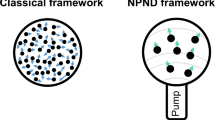Abstract
We propose a method for finding a priori undefined structures of unknown temporal fluctuations for frequency oscillators of various intensities as part of the output signals of synchronized dynamical systems. Unlike traditional approaches, the developed method is based on the continuous wavelet transform of the observed signal and is efficient in cases when frequency characteristics of the desired pattern are close to the noise characteristics of the output signal.
Similar content being viewed by others
References
Sedov, A.S. and Racheva, S.N., Applying Wavelet Analysis to Study Impulse Activity of Neurons in the Human Brain, Proc. 9th Conf. “Neiroinformatika-2007,” 2007, vol. 2, no. 1, pp. 77–87.
Basar, E., Schurmann, M., Demiralp, T., Basar-Eroglu, C., and Ademoglu, A., Event-related Oscillations are ‘Real Brain Responses’—Wavelet-Analysis and New Strategies, Int. J. Psychophysiol., 2001, vol. 39, pp. 91–127.
Misrikhanov, A.M., Wavelet Transform Methods: Application in Electroenergetics, Autom. Remote Control, 2006, vol. 67, no. 5, pp. 682–697.
Blanco, S., Figliola, A., Quiroga, R.Q., Rosso, O.A., and Serrano, E., Time-Frequency Analysis of Electroencephalogram Series. III. Wavelet Packets and Information Cost Function, Phys. Rev. E, 1998, vol. 57, pp. 932–940.
Rosso, O.A., Blanco, S., Yordanova, J., Kolev, V., Schurmann, M., Figliola, A., and Basar, E., Wavelet Entropy: A New Tool for Analysis of Short Duration Brain Electrical Signals, J. Neurosci. Meth., 2001, vol. 105, pp. 65–75.
Yordanova, J., Kolev, V., Rosso, O.A., Schurmann, M., Sakowitz, O.W., Ozgoren, M., and Basar, E., Wavelet Entropy Analysis of Event-Related Potentials Indicates Modality-Independent Theta Dominance, J. Neurosci. Meth., 2002, vol. 117, pp. 99–109.
Smolentsev, N.K., Osnovy teorii veivletov. Veivlety v MATLAB (Fundamentals of Wavelet Theory. Wavelets in MATLAB), Moscow: DMK Press, 2005.
Rangaiyan, R.M., Analiz biomeditsinskikh signalov. Prakticheskii podkhod (Analysis of Biomedical Signals. A Practical Approach), Moscow: Fizmatlit, 2007.
Cek, M.E., Ozgoren, M., and Savaci, F.A., Continuous Time Wavelet Entropy of Auditory Evoked Potentials, Computers Biol. Medici., 2010, vol. 40, pp. 90–96.
Astaf’eva, N.M., Wavelet Analysis: Theoretical Foundations and Sample Applications, Uspekhi Fiz. Nauk, 1996, vol. 166, no. 11, pp. 1145–1170.
Author information
Authors and Affiliations
Corresponding authors
Additional information
This paper was recommended for publication by V.I. Vasil’ev, a member of the Editorial Board
Rights and permissions
About this article
Cite this article
Shcherban, I.V., Kirilenko, N.E. & Krasnikov, S.O. A Search Method for Unknown High-Frequency Oscillators in Noisy Signals Based on the Continuous Wavelet Transform. Autom Remote Control 80, 1279–1287 (2019). https://doi.org/10.1134/S0005117919070051
Received:
Revised:
Accepted:
Published:
Issue Date:
DOI: https://doi.org/10.1134/S0005117919070051




